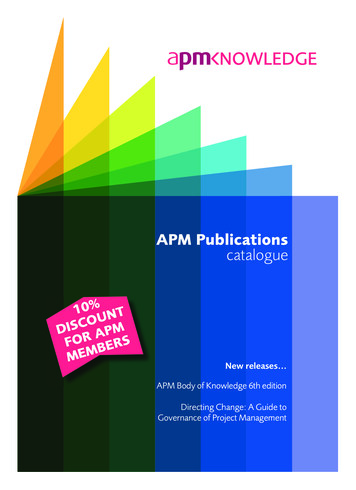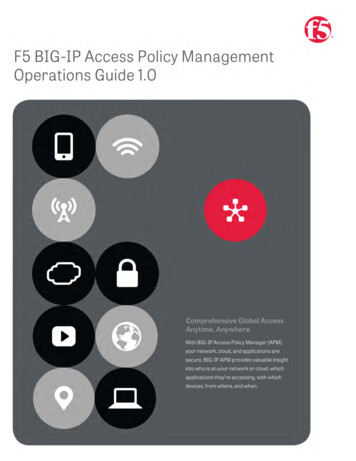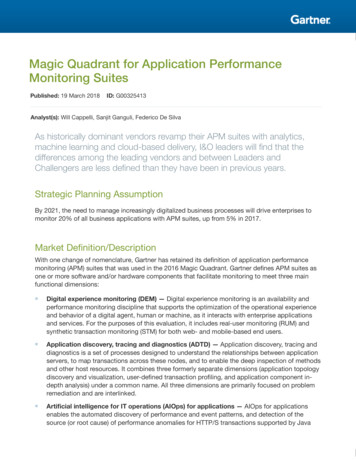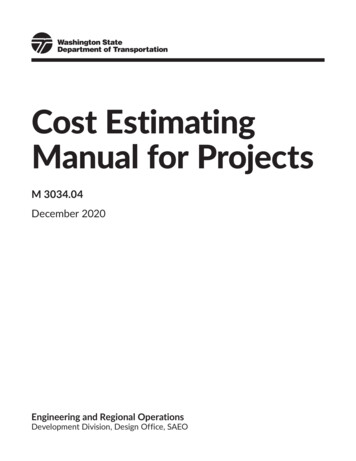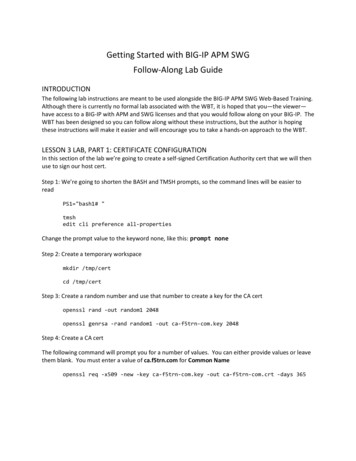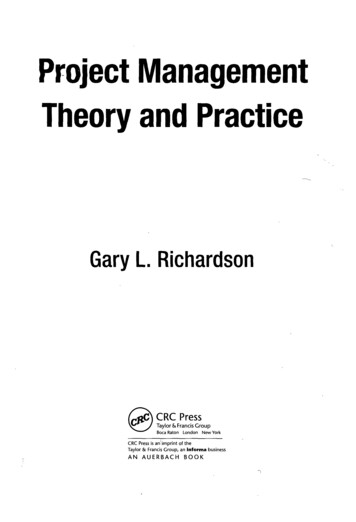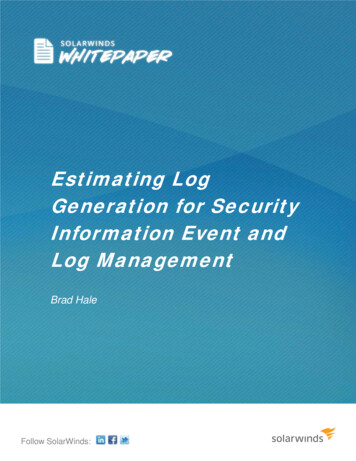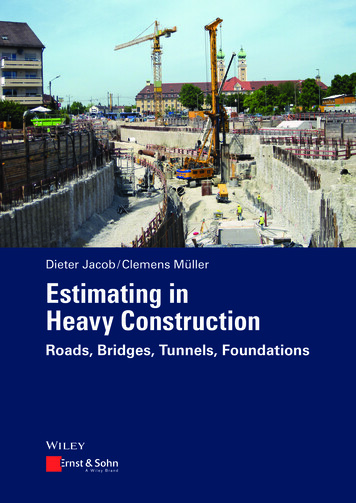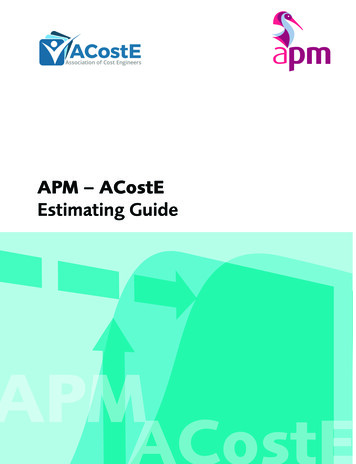
Transcription
APM – ACostEEstimating GuideFor Project, Programme and Portfolio Managers
ContentsTable of Figures vForeword viAcknowledgements viiPurpose and reason for this guide viiiEstimating framework x11112222566772Developing the estimating plan 1.1 Stakeholder engagement and mobilisation 1.1.1 Stakeholder commitment 1.1.2 Responsibility assignment matrix (RAM) 1.1.3 Interpretation of stakeholder objectives and targets 1.2 Understanding the estimate scope 1.2.1 Scoping the estimate 1.2.2 Understanding the estimate maturity requirements 1.3 Manage the information requirements 1.3.1 Identifying the information requirements 1.3.2 Storing information 1.3.3 Reviewing the maturity of the information available 1.3.4 Revising the ADORE in line with informationmaturity risk 1.3.5 Data normalisation 1.4 Prepare the estimating plan 1.4.1 Agreeing the estimating approach(es) to be used 1.4.2 Agreeing the competency requirements of the team 1.4.3 Agreeing the schedule of estimating activities andproject dependencies 1.4.4 Updating the estimating RAM 1.4.5 Defining the toolsets and information communicationmedia Creating the base estimate 2.1 Estimate management 88999910101111iii
Contents2.1.1 Iterative process 2.1.2 Configuration control 2.2 Estimating approach 2.2.1 Top-down approach 2.2.2 Bottom-up approach 2.2.3 Relying on the work of others – ‘ethereal’ approach 2.3 Estimating methods 2.3.1 Analogy 2.3.2 Parametric 2.3.3 Trusted source 2.4 Documenting the basis of estimate (BoE) 1111121214161719202021Risk, opportunity and uncertainty assessment 3.1 Assessing uncertainty in the baseline activities 3.2 Link to the risk management process 3.3 Link to schedule risk analysis 3.4 Holistic review of risk, opportunity and uncertainty 3.4.1 Top-down approach 3.4.2 Bottom-up approach – Monte Carlo simulation 3.4.3 Dealing with inherent optimism bias in risk andopportunity 3.4.4 Taking a balanced view of risk, opportunity anduncertainty 232324262727294Overall estimate validation, challenge and approval 4.1 Estimate maturity review 4.1.1 Maturity definition 4.1.2 Maturity assessment 4.1.3 Why is maturity assessment important? 4.1.4 Estimate review 4.1.5 Estimate approval 353636384141435Estimates to completion 5.1 EAC top-down approach 5.2 Bottom-up approach 5.3 Risk and opportunity management in EAC 444546466Ethics in estimation 4733233Glossary 49Acronyms and abbreviations 55References 56iv
Table of .73.83.94.14.24.34.45.1Estimating framework Top-down example Project life cycle Bottom-up example Potential suitable use of ethereal approach Estimating methods Example two-factor analogy Example parametric with two cost drivers Different types of distribution Schedule risk analysis Time phased cost profile Realistic distribution Monte Carlo Risk, opportunity and uncertainty evaluation Monte Carlo optimistically biased Comparison of bottom-up and top-down approaches torisk, opportunity and uncertainty Rolling wave estimating Example of maturity definition Example of estimate maturity assessment Example of maturity assessment Example of a maturity scale Earned value S-curve vx131415171819212427282930313133343738394044
ForewordEstimation and its diligent application within any project is one of the cornerstonesof successful project delivery. This guide has been created to assist the currentand next generation of project stakeholders to understand the core values,information sets and underpinning knowledge that, if applied diligently, willimprove the clarity and robustness of an estimate, informing the organisationwith transparency and clarity and supporting better decision making.The Association for Project Management (APM) and the Association of CostEngineers (ACostE) have collaborated to bring this guide to you. All thecollaborators have an excellent understanding of the challenges faced whengenerating an estimate that is fit for purpose, having had the experience of real-lifesituations where good estimates made the difference in delivering the project, anda burning desire to share their combined knowledge for the benefit of all.Professor Andy LangridgeDirector of business development, ARES Corporationvi
Purpose and reason forthis guideThe purpose of this guide is to provide a fundamental understanding of themethods of cost estimating and it explains a number of standard approachesavailable to promote good practice.Estimates are critical to the project manager as they are needed to makeinformed decisions about projects across the different stages of the whole projectlife cycle, hence the cooperation of the Association of Cost Engineers (ACostE)and the Association for Project Management (APM) in publishing this guide. Inproject management, effective monitoring of a project’s performance dependson having an appropriate, high-quality estimate against which progress can bemeasured.For instance:nnnnnInvestment committees require estimates in order to predict return oninvestment and hence determine whether to support project proposals andthe level of finance to invest in them.Cost estimates form part of option appraisals.Mature organisations often review projects at key stages and require them tomeet internal governance guidelines on cost-benefit-risk.Organisations that manage a portfolio of projects require credible costestimates in order to manage the spending profile of the portfolio.Good management practice needs to understand the impact of a projectchange, including risks and opportunities.There is long-standing evidence that underestimation of project costs is a keyreason for project failure. For instance, the National Audit Office’s 2001 reportModernising Construction (Comptroller and Auditor General, 2001) found thatlimited understanding of the true cost was one of the main reasons that 70 percent of public sector construction projects were delivered late or over budget.Industry surveys (KPMG, 2015) indicate that this is still the case. Academicshave collected evidence for overruns costing billions of pounds in majorviii
Purpose and reason for this guideinfrastructure projects worldwide (Flyvbjerg, 2003). More recent studies(Comptroller and Auditor General, January 2017) have shown that these errorswere often due to not taking estimating seriously enough, hampered by poorquality data and unrealistic assumptions (National Audit Office, December 2013).By their very nature estimates are speculative; the word estimating issynonymous with approximation and guessing, yet estimates are vital for sounddecision-making, planning and financial management.Different techniques may be appropriate at different stages in a project’sdevelopment. This guide will focus on cost estimating method and approaches.However, the advice in this guide is not limited to initial cost estimates; it is equallyapplicable to forecasting and to other forms of estimating, for example, time,schedule or performance.The guide is not limited to public sector construction, infrastructure or defenceprojects; it is equally applicable to the private sector and a wider range of projects,for example, if you are recruiting a new member of staff, or building the world’sfastest car, launching a new service, or licensing a new drug – every project needsa robust estimate.ix
Estimating frameworkFigure 0.1 Estimating frameworkEstimating consists of a number of activities, which provide a framework forgenerating and continuously improving an estimate. The diagram above shows atypical estimating framework, which includes the activities covered in the guide.A definition of the terms used in the diagram above can be found in theglossary and are explained throughout this guide.x
2Creating the baseestimate2.1 Estimate management2.1.1 Iterative processBefore starting any cost estimate, it is important to understand that it will be aniterative process. It is extremely unlikely that all information will be available atthe same level of maturity at the start of the project. This means that the estimatormust manage the estimating process as an iterative one. The estimator willprogress through the various stages of the estimating process (see Figure 0.1:Estimating framework), and at each stage the individual’s knowledge will developas more up-to-date information becomes available. If the estimator plans for aniterative process and operates configuration control, it will facilitate these changesin a controlled manner.2.1.2 Configuration controlA key principle of cost estimating is the ability to trace and document all aspects ofthe analysis, from raw data to final outputs. To achieve this, robust configurationcontrol is required. Considering that estimating is an iterative process, configurationcontrol will provide a method to ensure that the most current information is used.It is important to tailor the extent of configuration management required. For asimple project with a small number of data points, a simple naming conventioncould be sufficient to control the configuration (e.g. yyyy.mm.dd [name] v1.n).Whereas for more complex projects, full baseline management and change controlmay be required to ensure all information is configured appropriately. APMprovides comprehensive guidance on configuration management which can betailored to the needs of the estimating process; see APM Body of Knowledge 7thedition (APM, 2019).11
Estimating Guide2.2 Estimating approachAn estimating approach is the direction, or means of arriving at an estimate, andto some degree implies the level of detail at which the estimate is created. Withcomplex projects, it is often considered to be good practice to create an estimateusing more than one approach as a means of providing a greater level ofconfidence in the output advised, thereby testing the robustness andinterpretation of the data, the assumptions and the methodologies employed.2.2.1 Top-down approachIn a top-down approach to estimating, the estimator reviews the overall scope ofa project in order to identify the major elements of work and characteristics(drivers) that could be estimated separately from other elements. Typically, theestimator might consider a natural flow down through the work breakdownstructure (WBS), product breakdown structure (PBS) or service breakdownstructure (SBS).The estimate scope may be considered as a whole, or broken down to differenthigh levels of WBS as required (see Figure 2.1). The overall project scope mustbe covered by the range of non-overlapping work packages selected, althoughnot all work packages need to be estimated at the same level of WBS. This allowsthe estimator to use the maturity and/or uncertainty in the key informationavailable to produce the most appropriate level of estimate. The overall projectbase estimate would be created by summing these high level estimates. Thisshould not be confused with the bottom-up approach where all the lower levelswould be aggregated.Over the life of the estimate these higher-level work packages and theassociated higher-level estimates may be broken down into more detailed ormore refined elements, which ultimately will facilitate a bottom-up approach (seeFigure 2.2).A top-down approach is frequently used for creating rough order of magnitude(ROM) estimates, otherwise known as ball-park estimates, where the level ofdetail available is limited. As a general rule, a top-down estimate requires lesstime and effort to produce than one produced using a bottom-up approach.Top-down estimates are appropriate at the beginning of the life cycle when largenumbers of alternative options need to be estimated and considered. As thesolution matures and more information becomes available, there is an increasedopportunity to produce bottom-up figures. However, a top-down approach12
Estimating frameworkFigure 2.1 Top-down exampleSource: Alan R Jones 2019can still be useful throughout the life cycle of a project, e.g. for validationpurposes.The main benefit of working at a higher level is that there is a tendency touse more holistic data from previous projects or products, including unmitigatedand unforeseen risks, and scope creep. This can reduce the risk of emergingwork activities or costs being overlooked. As a result, top-down estimates aretypically greater than those created by a bottom-up approach.Base estimates created by a top-down approach should exclude considerationof additional risks and opportunities. These should be considered separately byeither a top-down or bottom-up approach as part of the formulation of the projectbaseline estimate. See section 3.It is considered good practice to express an uncertainty range around atop-down estimate, based on the maturity of the information available, and theestimating methodologies employed. According to the NAO survival guide tochallenging costs in major projects, (National Audit Office, 2018) “Early costestimates should be presented as a range and never a point estimate”. Note thatAPM and ACostE believe this should apply to all cost estimates.13
3Risk, opportunity anduncertainty assessment3.1 Assessing uncertainty inthe baseline activitiesThere will always be uncertainty (or a lack of exactness) in the cost estimate ofprojects. This happens for various reasons, including uncertainty about thedetailed scope of work and uncertainty about the levels of productivity that willbe achieved. In addition to these factors, there will be risks and opportunities;these are things that may or may not happen, but if they do they will impact theestimate. Risks are discrete events that will have a degree of uncertainty over theexact value. Baseline tasks will occur, but the actual value will have uncertainty.For example, while driving home (baseline task), the journey time is uncertaindue to variable traffic conditions (i.e. traffic lights). However, in addition therecould be a risk of a delay of uncertain duration due to an accident.Uncertainty is the inherent and potentially uncontrollable variability inestimating the actual cost and schedule. It can be considered as a tolerance bandon the understanding of the scope. Uncertainties arise because the organisationdoes not have a complete understanding of the proposed task or the solution. Anuncertainty is an expression of something that will happen; the actual projectvalue will not be known but is expected to lie within a defined range. Someuncertainties will express natural variation; for example, my journey home eachday varies by maybe five minutes less or 10 minutes more.Most baseline tasks in a work breakdown structure will have uncertainty,which can be expressed as three values: the minimum (unlikely to be less than),most likely value and maximum (unlikely to exceed). The 3-point estimate shouldexpress the range of uncertainty – excluding risks or opportunities.Where there is uncertainty in the scope definition of the baseline activities, the3-point estimate can be used to express the extremes of a minimum (or simplisticscope requirement) and a maximum (or complex scope requirement).Alternatively, any potential but improbable extreme in the scope requirements23
Estimating Guidemight be expressed as a risk or opportunity. Care must be taken not to duplicateor overlap any extremes expressed in both ways.3.2 Link to the risk management processThe evaluation of the net effect of risks and opportunities cannot be performedin isolation from the baseline activities, nor can they be evaluated in isolationfrom the project’s risk management process (i.e. do not re-invent the wheel).Most of the data requirements to manage risks and opportunities are also neededto evaluate their net impact; for example, 3-point estimate of the individualrisk or opportunity cost impact, probability of occurrence, risk retirement date,mitigation plan, etc. In addition to these parameters, in order to evaluate their netimpact, there is a need to express the 3-point estimate range of potential valuesas a probability distribution. This then allows probabilistic modelling of the risksand opportunities to be performed in Monte Carlo simulation in conjunction withbaseline activities.Risks and opportunities are discrete events whose occurrences are expressedby a probability of occurrence, modelled by a Bernoulli distribution.The most common forms of probability distributions to model uncertaintyinclude normal, lognormal, exponential, triangular and uniform.Figure 3.1 Different types of distribution24
Estimating frameworkWhen to use these different types of distribution:Normal distribution:This symmetrical distribution often represents the spread and frequency ofvalues in naturally occurring observations in nature, such as the height ofadult males or females of a given ethnicity. It can also represent the distributionof values from man-made systems such as the accuracy and/or precision ofmachining operations. The distribution can often be used to represent therange of values for system or sub-system level costs, even where theconstituent elements of those systems or sub-systems are not normallydistributed. The scatter or deviation of values around a linear cost estimatingrelationship is also expected to be normally distributed.Lognormal distribution:This distribution can be used in reliability analysis to model the repair time ofitems, in particular in relation to the fatigue-stress characteristics ofmechanical systems. It is often an empirical distribution observed in naturalgrowth or human behaviour systems. When a variable is deemed to belognormally distributed in linear space, its values will be normally distributedin logarithmic space. As a consequence, the scatter or deviation of valuesaround a power or exponential cost estimating relationship is expected to belognormally distributed.Triangular distribution:The triangular distribution is frequently used as a default distribution wherethere is some knowledge or perception of a most likely value, and also anappreciation of the likely minimum or maximum values of a variable. In costand schedule scenarios, data is more likely to be positively skewed; i.e.where the difference from the most likely to the maximum is greater than thedifference between the most likely and the minimum. Aggregated systemlevel variables are more likely to be symmetrically distributed.Uniform distribution:The uniform distribution is frequently used as a default distribution wherethere is some knowledge or perception of the likely minimum or maximum25
6Ethics in estimationThe estimating codes of conduct lay down the behaviours we would like to seefrom both the estimator and the customer of those estimates. The customer isdefined in this guide as the person who asks for the estimate: project manager,chief engineer, etc.1. No individual employee, team, organisation, project (or programme), orvendor shall be required to develop, submit or certify any estimate for whichthey do not have appropriate confidence.2. There shall be means to address without retribution any concerns about theintegrity or ethics in the development of any estimate and those means shallbe communicated clearly.3. In order to protect the integrity, security, image and reputation of the company,senior leadership will confirm the compliance of their respective organisationsto estimation policy and standards, be held accountable for the same, andshall delegate as appropriate levels of assurance and compliance to theestimation policy and standards.4. Any known impacts to estimates, including those for remaining costs ofprojects in progress, shall be documented and reported as quickly as possible,and no later than in accordance with documented policy.5. Estimate values, changes and associated impacts shall be communicatedhonestly, ethically and on a timely basis, to all customers, both external andinternal.6. At all times, the estimator and customer shall create an environment of mutualtrust and respect. They shall provide open feedback and views withoutcriticism. At no time shall bullying, intimidation or disrespectful behaviour betolerated.All professional bodies have a code of conduct which their members are expectedto follow. These include, but are not limited to:ECUK Spec – Engineering Council www.engc.org.uk/ukspecAPM – Association of Project Management www.apm.org.uk47
GlossaryThe terms in this glossary represent the views of both APMBok (APM, 2019),ACostE and the authors of the guide.3-point estimate/three-pointestimate[APM] An estimate in which optimistic best case, pessimistic worstcase and most likely values are given.[ACostE] A three-point estimate represents three cases produced byestimating. Some organisations (and this guide) refer to these as theminimum, the most likely and the maximum.The three-point estimating technique is used for the construction ofan approximate distribution representing the uncertainty of futureevents; this will ensure the estimate is credible.AccuracyThe correctness of an estimate. This can be measured as thepercentage error between the estimate and actual. In the case of3-point estimates, an estimate is considered accurate if the actualcost/schedule lies inside the estimate uncertainty range.ADOREAssumptions, dependencies, opportunities, risks, exclusions(Shermon D, 2017)AssumptionsA statement that is taken as being true for the purposes of estimating,but which could change later. An assumption is made where somedata is not available or facts are not yet known.BaselineThe reference levels against which a project, programme or portfoliois monitored and controlled.Bottom-upestimating[APM] An estimating technique that uses detailed specifications toestimate time and cost for each product or activity. Also known asanalytical estimating. This should not be confused with the‘Estimating Method of Estimating by Analogy’ (Section 2.3.1).[ACostE] An approach to estimating all individual work packages oractivities with appropriate level of detail, which are then rolled up tohigher-level estimates. The accuracy of bottom-up estimating isimproved when individual work packages or activities are defined inmore detail. See section 2.2.2.49
APM – ACostE Estimating Guide For Project, Programme and Portfolio Managers APM – ACostE Estimating Guide C M Y K C M Y K C M Y K C M Y K Tel. (UK) 0845 458 1944 Tel. (Int.) 44 1844 271 640 Email info@apm
